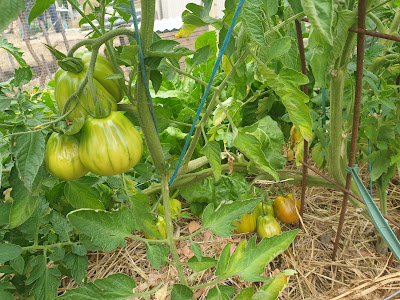Visit Lower Snug Liz and Mark 2024
The group visited Liz and Mark's permaculture food garden on a warm late summer's day. Despite months and months of extremely dry conditions in southern Tasmania there was still a lot to see and discuss.
Liz and Mark have been involved in the past in the idea of using water tanks as gardens by making them into raised vegetable beds. Their garden contains many of these, and most are protected from hungry wildlife by fences or netting. Among the advantages of the raised beds are less bending for the gardener, as well as deeper -and warmer- topsoil. The soil on their property is a reasonable sandy loam over clay on top of the sandstone underneath. By making a fertile growing medium in the raised beds they have increased the productivity of their patch enormously.

The bottom one third of each bed is crusher dust (which is of volcanic origin and contains many minerals), the rest of the bed is filled with layered organic material just like many people would build a compost heap. It is seeded with worms and other soil life, and then covered with mulch and left undisturbed. Over time, the biological life breaks the nutrients down and turns the whole bed into fertile friable soil. Liz keeps adding layers as time goes on, while at the same time planting straight into the worm castings underneath. She also waters regularly with liquid manures made from kelp (from beach or bought) and lots of comfrey, and the great results were obvious to us all.
The chickens normally contribute their manure straight onto the gardens. For today's garden visit they were confined to their night quarters.
Here is Max, introducing Liz (holding a pink folder) to the group.
Liz uses Life Force Gold which has lots of good ingredients suitable for most gardens in Australia. She mixes this with blood and bone and seasol pellets and applies it once or twice a year. She also adds lime to her soil once a year, but never at the the same time as the nitrogen. And there was much more to learn about permaculture and soil additives to balance the nutrients, minerals and microbes in the soil.
We were all keen to get into the garden for a look at the results though, and the group happily spread out into the garden to observe and discuss. Liz and Mark are on tank water, so for the moment, the beds have to get along on minimal drip feeding. Nevertheless, the strawberries were still producing nicely!
A super productive zucchini bed.
A good illustration of the desperation of the wildlife in the dry landscape: this cumquat was lush and green a few days ago and has suddenly been grazed almost bare to where ever the pademelon could reach it.
This stone fruit tree had been suffering badly from leaf curl and Liz had almost given up on it. Then, last winter, she moved it to a sunnier and drier location. It is now looking great, and there are high hopes for a nice crop next summer.
Tomatoes doing very well, despite growing in the same spot for years. Liz reckons the healthy soil is the reason she can do this successfully.
Autumn raspberries are a delight.
There are lots of lemons coming on and the Tahitian lime is also loaded.
 |
| Myer lemon |
 |
| Tahitian lime |
For pumpkins Liz grows mainly butternuts, since they are her favourite. Onions also going well.
Liz does not make compost on a pile, instead she spreads all compostable materials out in the garden, and under the mulch. This way, the whole garden becomes the compost area, benefitting the soil everywhere. Comfrey is allowed to grow all over the patch too, and its leaves are regularly chopped and added to the soil.
For the paths, Liz has chosen to sow clover into the crusher dust. This provides ground cover, it can be walked on, and it too gets added to the soil.
The apples trees in the covered orchard are bursting with fruit. It's looking great!
The produce table was beckoning as was the morning tea! And what a great spot to enjoy a cuppa with friends and other like-minded gardeners. Thank you to all who contributed and a big thanks to Liz and Mark for sharing their story and garden with us.





















No comments:
Post a Comment
Note: Only a member of this blog may post a comment.